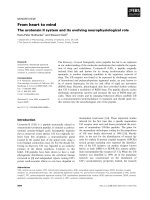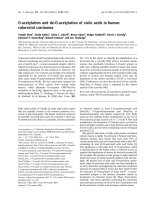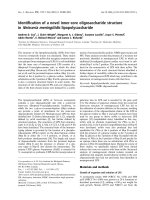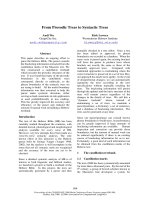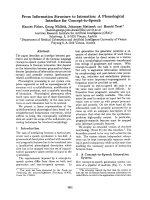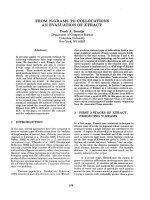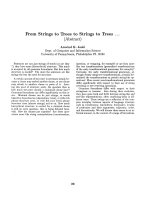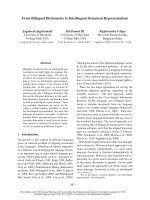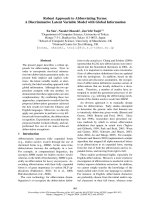Báo cáo khoa học: "From Submit to Submitted via Submission: On Lexical Rules in Large-Scale Lexicon Acquisition" docx
Bạn đang xem bản rút gọn của tài liệu. Xem và tải ngay bản đầy đủ của tài liệu tại đây (759.62 KB, 8 trang )
From
Submit
to
Submitted
via
Submission:
On Lexical Rules in
Large-Scale Lexicon Acquisition.
Evelyne Viegas, Boyan Onyshkevych §, Victor
Raskin §~, Sergei
Nirenburg
Computing Research Laboratory,
New Mexico State University,
Las Cruces, NM 88003, USA
viegas,
boyan, raskin, sergei~crl,
nmsu.
edu
Abstract
This paper deals with the discovery, rep-
resentation, and use of lexical rules (LRs)
during large-scale semi-automatic compu-
tational lexicon acquisition. The analy-
sis is based on a set of LRs implemented
and tested on the basis of Spanish and
English business- and finance-related cor-
pora. We show that, though the use of
LRs is justified, they do not come cost-
free. Semi-automatic output checking is re-
quired, even with blocking and preemtion
procedures built in. Nevertheless, large-
scope LRs are justified because they facili-
tate the unavoidable process of large-scale
semi-automatic lexical acquisition. We also
argue that the place of LRs in the compu-
tational process is a complex issue.
1 Introduction
This paper deals with the discovery, representation,
and use of lexical rules (LRs) in the process of large-
scale semi-automatic computational lexicon acqui-
sition. LRs are viewed as a means to minimize the
need for costly lexicographic heuristics, to reduce the
number of lexicon entry types, and generally to make
the acquisition process faster and cheaper. The
findings reported here have been implemented and
tested on the basis of Spanish and English business-
and finance-related corpora.
The central idea of our approach - that there
are systematic paradigmatic meaning relations be-
tween lexical items, such that, given an entry for
one such item, other entries can be derived auto-
matically- is certainly not novel. In modern times,
it has been reintroduced into linguistic discourse
by the Meaning-Text group in their work on lex-
ical functions (see, for instance, (Mel'~uk, 1979).
§ also of US Department of Defense, Attn R525, Fort
Meade, MD 20755, USA and Carnegie Mellon University,
Pittsburgh, PA. USA. §§ also of Purdue University NLP
Lab, W Lafayette, IN 47907, USA.
It has been lately incorporated into computational
lexicography in (Atkins, 1991), (Ostler and Atkins,
1992), (Briscoe and Copestake, 1991), (Copestake
and Briscoe, 1992), (Briscoe et al., 1993)).
Pustejovsky (Pustejovsky, 1991, 1995) has coined
an attractive term to capture these phenomena: one
of the declared objectives of his 'generative lexi-
con' is a departure from sense enumeration to sense
derivation with the help of lexical rules. The gen-
erative lexicon provides a useful framework for po-
tentially infinite sense modulation in specific con-
texts (cf. (Leech, 1981), (Cruse, 1986)), due to
type coercion (e.g., (eustejovsky, 1993)) and simi-
lar phenomena. Most LRs in the generative lexi-
con approach, however, have been proposed for small
classes of words and explain such grammatical and
semantic shifts as
+count
to
-count
or
-common
to
+common.
While shifts and modulations are important, we
find that the main significance of LRs is their
promise to aid the task of
massive
lexical acqui-
sition.
Section 2 below outlines the nature of LRs in our
approach and their status in the computational pro-
cess. Section 3 presents a fully implemented case
study, the morpho-semantic LRs. Section 4 briefly
reviews the cost factors associated with LRs; the
argument in it is based on another case study, the
adjective-related LRs, which is especialy instructive
since it may mislead one into thinking thai. LRs are
unconditionally beneficial.
2 Nature of Lexical Rules
2.1 Ontological-Semantic Background
Our approach to NLP can be characterized as
ontology-driven semantics (see, e.g., (Nirenburg and
Levin, 1992)). The lexicon for which our LRs are in-
troduced is intended to support the computational
specification and use of text meaning representa-
tions. The lexical entries are quite complex, as
they must contain many different types of lexical
knowledge that may be used by specialist processes
for automatic text analysis or generation (see, e.g.,
32
(Onyshkevych and Nirenburg, 1995), for a detailed
description). The acquisition of such a lexicon, with
or without the assistance of LRs, involves a substan-
tial investment of time and resources. The meaning
of a lexical entry is encoded in a (lexieal) semantic
representation language (see, e.g., (Nirenburg et al.,
1992)) whose primitives are predominantly terms in
an independently motivated world model, or ontol-
ogy (see, e.g., (Carlson and Nirenburg, 1990) and
(Mahesh and Nirenburg, 1995)).
The basic unit of the lexicon is a 'superentry,' one
for each citation form holds, irrespective of its lexi-
cal class. Word senses are called 'entries.' The LR
processor applies to all the word senses for a given
superentry. For example,
p~vnunciar
has (at least)
two entries (one could be translated as "articulate"
and one as "declare"); the LR generator, when ap=
plied to the superentry, would produce (among oth-
ers) two forms of
pronunciacidn,
derived from each
of those two senses/entries.
The nature of the links in the lexicon to the ontol-
ogy is critical to 'the entire issue of LRs. Represen-
tations of lexical meaning may be defined in terms
of any number of ontological primitives, called
con=
cepts.
Any of the concepts in the ontology may be
used (singly or in combination) in a lexical meaning
representation.
No necessary correlation is expected between syn-
tactic category and properties and semantic or onto-
logical classification and properties (and here we def-
initely part company with syntax-driven semantics-
see, for example, (Levin, 1992), (Dorr, 1993) -pretty
much along the lines established in (Nirenburg and
Levin, 1992). For example, although meanings of
many verbs are represented through reference to on-
tological EVENTs and a number of nouns are rep-
resented by concepts from the
OBJECT
sublattice~
frequently nominal meanings refer to EVENTs and
verbal meanings to OBJECTs. Many LRs produce
entries in which the syntactic category of the input
form is changed; however, in our model, the seman-
tic category is preserved in many of these LRs. For
example, the verb
destroy
may be represented by
an EVENT, as will the noun
destruction
(naturally,
with a different linking in the syntax-semantics in-
terface). Similarly,
destroyer
(as a person) would
be represented using the same event with the addi-
tion of a
HUMAN
as a filler of the agent case role.
This built-in transcategoriality strongly facilitates
applications such as interlingual MT, as it renders
vacuous many problems connected with category
mismatches (Kameyama et al., 1991) and misalign-
ments or divergences (Dorr, 1995), (Held, 1993) that
plague those paradigms in MT which do not rely on
extracting language-neutral text meaning represen-
tations. This transcategoriality is supported by LRs.
2.2 Approaches to LRs and Their Types
In reviewing the theoretical and computational lin-
guistics literature on LRs, one notices a number of
different delimitations of LRs from morphology, syn-
tax, lexicon, and processing. Below we list three
parameters which highlight the possible differences
among approaches to LRs.
2.2.1 Scope of Phenomena
Depending on the paradigm or approach, there are
phenomena which may be more-or less-appropriate
for treatment by LRs than by syntactic transfor-
mations, lexical enumeration, or other mechanisms.
LRs offer greater generality and productivity at the
expense of overgeneration, i.e., suggesting inappro-
priate forms which need to be weeded out before ac-
tual inclusion in a lexicon. The following phenomena
seem to be appropriate for treatment with LRs:
• Inflected Forms- Specifically, those inflectional
phenomena which accompany changes in sub-
categorization frame (passivization, dative al-
ternation, etc.).
• Word Formation- The production of derived
forms by LR is illustrated in a case study be-
low, and includes formation of deverbal nom-
inals
(destruction, running),
agentive nouns
(catcher).
Typically involving a shift in syn-
tactic category, these LRs are often less pro-
ductive than inflection-oriented ones. Conse-
quently, derivational LRs are even more prone
to overgeneration than inflectional LRs.
• Regular Polysemy - This set of phenomena
includes regular polysemies or regular non-
metaphoric and non-metonymic alternations
such as those described in (Apresjan, 1974),
(Pustejovsky, 1991, 1995), (Ostler and htkins,
1992) and others.
2.2.2 When Should LRs Be Applied?
Once LRs are defined in a computational scenario,
a decision is required about the time of application
of those rules. In a particular system, LRs can be
applied at acquisition time, at lexicon load time and
at run time.
• Acquisition Time - The major advantage of this
strategy is that the results of any LR expansion
can be checked by the lexicon acquirer, though
at the cost of substantial additional time. Even
with the best left-hand side (LHS) conditions
(see below), the lexicon acquirer may be flooded
by new lexical entries to validate. During the re-
view process, the lexicographer can accept the
generated form, reject it as inappropriate, or
make minor modifications. If the LR is being
used to build the lexicon up from scratch, then
mechanisms used by Ostler and Atkins (Ostler
and Atkins, 1992) or (Briscoe et al., 1995), such
as blocking or preemption, are not available as
33
automatic mechanisms for avoiding overgenera-
tion.
• Lexicon Load Time - The LRs can be applied
to the base lexicon at the time the lexicon is
loaded into the computational system. As with
run-time loading, the risk is that overgenera-
tion will cause more degradation in accuracy
than the missing (derived) forms if the LRs were
not applied in the first place. If the LR inven-
tory approach is used or if the LHS constraints
are very good (see below), then the overgener-
ation penalty is minimized, and the advantage
of a large run-time lexicon is combined with ef-
ficiency in look-up and disk savings.
• Run Time - Application of LRs at run time
raises additional difficulties by not supporting
an index of all the head forms to be used by the
syntactic and semantic processes. For example,
if there is an Lit which produces abusive-adj2
from abuse-v1, the adjectival form will be un-
known to the syntactic parser, and its produc-
tion would only be triggered by failure recovery
mechanisms if direct lookup failed and the
reverse morphological process identified abuse-
vl as a potential source of the entry needed.
A hybrid scenario of LR use is also plausible,
where, for example, LRs apply at acquisition time to
produce new lexical entries, but may also be avail-
able at run time as an error recovery strategy to
attempt generation of a form or word sense not al-
ready found in the lexicon.
2.2.3 LR Triggering Conditions
For any of the Lit application opportunities item-
ized above, a methodology needs to be developed
for the selection of the subset of LRs which are ap-
plicable to a given lexical entry (whether base or
derived). Otherwise, the Lits will grossly overgen-
erate, resulting in inappropriate entries, computa-
tional inefficiency, and degradation of accuracy. Two
approaches suggest themselves.
• Lit Itemization - The simplest mechanism of
rule triggering is to include in each lexicon en-
try an explicit list of applicable rules. LR ap-
plication can be chained, so that the rule chains
are expanded, either statically, in the speci-
fication, or dynamically, at application time.
This approach avoids any inappropriate appli-
cation of the rules (overgeneration), though at
the expense of tedious work at lexicon acquisi-
tion time. One drawback of this strategy is that
if a new LR is added, each lexical entry needs
to be revisited and possibly updated.
• Itule LIIS Constraints - The other approach is
to maintain a bank of LRs, and rely on their
LHSs to constrairi the application of the rules to
only the appropriate cases; in practice, however,
it is difficult to set up the constraints in such a
way as to avoid over- or undergeneration a pri-
or~. Additionally, this approach (at least, when
applied after acquisition time) does not allow
explicit ordering of word senses, a practice pre-
ferred by many lexicographers to indicate rela-
tive frequency or salience; this sort of informa-
tion can be captured by other mechanisms (e.g.,
using frequency-of-occurrence statistics). This
approach does, however, capture the paradig-
matic generalization that is represented by the
rule, and simplifies lexical acquisition.
3 Morpho-Semantics and
Constructive Derivational
Morphology: a Transcategorial
Approach to Lexical Rules
In this section, we present a case study of LRs based
on constructive derivational morphology. Such LRs
automatically produce word forms which are poly-
semous, such as the Spanish generador 'generator,'
either the artifact or someone who generates. The
LRs have been tested in a real world application, in-
volving the semi-automatic acquisition of a Spanish
computational lexicon of about 35,000 word senses.
We accelerated the process of lexical acquisition 1
by developing morpho-semantic LRs which, when
applied to a lexeme, produced an average of 25 new
candidate entries. Figure 1 below illustrates the
overall process of generating new entries from a ci-
tation form, by applying morpho-semantic LRs.
Generation of new entries usually starts with
verbs. Each verb found in the corpora is submitted
to the morpho-semantic generator which produces
all its morphological derivations and, based on a de-
tailed set of tested heuristics, attaches to each form
an appropriate semantic LR. label, for instance, the
nominal form comprador will be among the ones gen-
erated from the verb comprar and the semantic LR
"agent-of" is attached to it. The mechanism of rule
application is illustrated below.
The form list generated by the morpho-semantic
generator is checked against three MRDs (Collins
Spanish-English, Simon and Schuster Spanish-
English, and Larousse Spanish) and the forms found
in them are submitted to the acquisition process.
However, forms not found in the dictionaries are not
discarded outright because the MRDs cannot be as-
sumed to be complete and some of these ":rejected"
forms can, in fact, be found in corpora or in the
input text of an application system. This mecha-
nism works because we rely on linguistic clues and
a See (Viegas and Nirenburg, 1995) for the details on
the acquisition process to build the core Spanish lexicon,
and (Viegas and Beale, 1996) for the details oil the con-
ceptual and technological tools used to check the quality
of the lexicon.
34
verb list file:
coznpr~.r con~r
¢
:~: :.~;~::::~:,::.~.:;~ ~:::~-::::.: :.: ~::~::~:::::::.:::.~:::.::~ ~ :::.::~ ×.:
¢
derived verb list file:
ccn~xpra~,v,LRlevent
compra,n,LR2event
ii
:.:
~
forme
i ii ii:ii i iiii iiiiiii!iiiiiiiiiiiiiiiiiiJJii !i iii iiiii
accepted forms
rejected
forms
"comprar-V1
cat:
dfn:
ex:
aAmin:
syn:
sere:
V
acquire the possession or right
by
paying or promising to pay
troche eompro una nueva empress
jlongwel "18/1 15:42:44"
"root: []
rcat
0 bj: ~ [sem:
"buy
agent: fi-i] human
theme: [~] object
Figure 2: Partial Entry for the Spanish lexieal item
comprar.
Figure 1: Automatic Generation of New Entries.
therefore our system does not grossly overgenerate
candidates.
The Lexical Rule Processor is an engine which
produces a new entry from an existing one, such
as the new entry
compra
(Figure 3) produced from
the verb entry
comprar
(Figure 2) after applying the
LR2event rule. 2
The acquirer must check the definition and enter
an example, but the rest of the information is sim-
ply retained. The LEXical-RUT.~.S zone specifies the
morpho-semantic rule which was applied to produce
this new entry and the verb it has been applied to.
The morpho-semantic generator produces all pre-
dictable morphonological derivations with their
morpho-lexico-semantic associations, using three
major sources of clues: 1) word-forms with their cor-
responding morpho-semantic classification; 2) stem
alternations and 3) construction mechanisms. The
patterns of attachement include unification, concate-
nation and output rules 3. For instance
beber
can be
2We used the typed feature structures (tfs) as de-
scribed in (Pollard and Sag, 1997). We do not illustrate
inheritance of information across partial lexical entries.
3The derivation of stem alternations is beyond the
derived into
beb{e]dero, bebe[e]dor, beb[i]do, beb[i]da,
volver
into
vuelto,
and
communiear
into
telecommu-
nicac[on,
etc All affixes are assigned semantic fea-
tures. For instance, the morpho-semantic rule
LRpo-
larity_negative
is at least attached to all verbs belong-
ing to the -Aa class of Spanish verbs, whose initial
stem is of the form 'con', 'tra', or 'fir' with the corre-
sponding allomorph
.in
attached to it
(inconlrolable,
inlratable, ).
Figure 4 below, shows tlle derivational morphol-
ogy output for
eomprar,
with the associated lexical
rules which are later used to actually generate the
entries. Lexical rules 4 were applied to 1056 verb
citation forms with 1263 senses among them. The
rules helped acquire an average of 25 candidate new
entries per verb sense, thus producing a total of
31,680 candidate entries.
From the 26 different citation forms shown in Fig-
ure 4, only 9 forms (see Figure 5), featuring 16 new
entries, have been accepted after checking. 5
For instance,
comprable, adj, LR3feasibility-
allribulel,
is morphologically derived from
comprar,
scope of this paper, and is discussed in (Viegas et al.,
1996).
4We developed about a hundred morpho-semantic
rules, described in (Viegas et al., 1996).
5The results of the derivational morphology program
output are checked against, existing corpora and dictio-
naries, automatically.
35
"compra-N1
cat:
dfn:
ex:
admin:
syn:
sere:
lex-rul:
V
acquire the possession or right
by paying or promising to pay
LR2event "11/12 20:33:02"
[ oo,
buy]
comprar-Vl "LR2event"
Figure 3: Partial Entry for the Spanish lexical item
compra generated automatically.
and adds to the semantics of comprar the shade of
meaning of possibility.
In this example no forms rejected by the dic-
tionaries were found in the corpora, and therefore
there was no reason to generate these new entries.
However, the citation forms supercompra, precom-
pra, precomprado, autocomprar actually appeared in
other corpora, so that entries for them could be gen-
erated automatically at run time.
4 The Cost of Lexical Rules
It is clear by now that LRs are most useful in large-
scale acquisition. In the process of Spanish acquisi-
tion, 20% of all entries were created from scratch by
H-level lexicographers and 80% were generated by
LRs and checked by research associates. It should
be made equally clear, however, that the use of LRs
is not cost-free. Besides the effort of discoveriug and
implementing them, there is also the significant time
and effort expenditure on the procedure of semi-
automatic checking of the results of the application
of LRs to the basic entries, such as those for the
verbs.
The shifts and modulations studied in the litera-
ture in connection with the LRs and generative lex-
icon have also been shown to be not problem-free:
sometimes the generation processes are blocked-or
preempted-for a variety of lexical, semantic and
other reasons (see (Ostler and Atkins, 1992)). In
fact, the study of blocking processes, their view as
systemic rather than just a bunch of exceptions, is
by itself an interesting enterprise (see (Briscoe et al.,
1995)).
Obviously, similar problems occur in real-life
large-scale lexical rules as well. Even the most seem-
ingly regular processes do not typically go through
in 100% of all cases. This makes the LR-affected
entries not generable fully automatically and this is
why each application of an LR to a qualifying phe-
36
Derived form II POS I Lexical Rule
comprar v lrlevent
compra n lr2eventSb
compra n lr2theme_oLevent9b
comprado n lr2reputation_attla
comprador n lr2reputation_att2c
comprador n lr2social_role_rel2c
comprado n lr2theme_of_event la
comprado axtj lr3event_telicla
comprable adj lr3feasibility_ att 1
compradero adj lr3feasibility_att2c
compradizo adj lr3feasibility_att3c
comprado adj lr3reputation_ art 1 a
comprador adj lr3reputation_att2c
comprador adj lr3social_ role_relc
malcomprar I[ v neg_evM_attitudel lr 1event
malcomprado adj lr3event_telicla
subcomprar I v part_oLrelation3 lrlevent
subcomprado I adj lr3event_telicla
autocomprar v agent_beneficiarylb lrlevent
autocompra n lr2event8b
autocompra n lr2theme_oLevent9b
autocomprado adj lr3event_telicla
recomprar v aspect_iter_semelfact 1 lrlevent
recompra n lr2eventSb
recompra n lr2theme_oLevent9b
recomprado adj lr3event_telicla
supercomprar v evM_attitude6 lrlevent
supercompra n lr2eventSb
supercompra n lr2theme_oLevent9b
supercomprado adj lr3event_telicla
precomprar v before_temporal_rel5 lrlevent
precompra n Ir2eventSb
precompra n lr2theme_oLevent9b
precomprado adj lr3event_telicla
deseomprar v opp_rel2 lrlevent
descompra n lr2event8b
descompra n lr2theme_of_event9b
descomprado adj lr3event_telicla
compraventa n lr2p_eventSb lr2s_eventSb
Figure 4: Morpho-semantic Output.
Derived form [[ POS [ Lexical Rule
comprar v lrlevent
comprado n lr2theme_oLevent 1 a
compra n lr2event8b
comprado n lr2reputation_attla
comprador n lr2agent_of2c
comprador n lr2sociaJ_role_rel2c
compra n lr2theme_oLevent9b
comprable adj lr3feasibility_att ]
compradero adj lr3feasibility_att2c
compradizo adj lr3feasibility_att3c
I comprado adj lr3agent_ofla
comprador adj lr3reputation_att2c
comprador adj lr3social_role_rel2c
comprado adj lr3event_telicla
recomprar v aspectiter_semelfact I lrlevent
, recompra n lr2event8b
recompra n lr2theme_of_event9b
compraventa l[ n [
lr2p_event8b lr2s_event8b
Figure 5: Dictionary Checking Output.
nomenon must be checked manually in the process
of acquisition.
Adjectives provide a good case study for that. The
acquisition of adjectives in general (see (Raskin and
Nirenburg, 1995)) results in the discovery and ap-
plication of several large-scope lexical rules, and it
appears that no exceptions should be expected. Ta-
ble 1 illustrates examples of LRs discovered and used
in adjective entries.
The first three and the last rule are truly large-
scope rules. Out of these, the
-able
rule seems to be
the most homogeneous and 'error-proof.' Around
300 English adjectives out of the 6,000 or so, which
occur in the intersection of LDOCE and the 1987-89
Wall Street Journal corpora, end in
-able.
About 87% of all the
-able
adjectives are like
read-
able:
they mean, basically, something that can be
read. In other words, they typically modify the noun
which is the theme (or beneficiary, if animate) of the
verb from which the adjective is derived:
One can read the book The book is readable.
The temptation to mark all the verbs as capable
of assuming the suffix
-able
(or
-ible)
and forming
adjectives with this type of meaning is strong, but it
cannot be done because of various forms of blocking
or preemption. Verbs like
kill, relate,
or
necessitate
do not form such adjectives comfortably or at all.
Adjectives like
audible
or
legible
do conform to the
formula above, but they are derived, as it were, from
suppletive verbs,
hear
and
read,
respectively. More
distressingly, however, a complete acquisition pro-
cess for these adjectives uncovers 17 different com-
binations of semantic roles for the nouns modified
by the
-ble
adjectives, involving, besides the "stan-
dard" theme or beneficiary roles, the agent, experi-
encer, location, and even the entire event expressed
by the verb. It is true that some of these combi-
nations are extremely rare (e.g.
perishable),
and all
together they account for under 40 adjectives. The
point remains, however, that each case has to be
checked manually (well, semi-automatically, because
the same tools that we have developed for acquisi-
tion are used in checking), so that the exact meaning
of the derived adjective with regard to that of the
verb itself is determined. It turns out also that, for a
polysemous verb, the adjective does not necessarily
inherit all its meanings (e.g.,
perishable
again).
5 Conclusion
In this paper, we have discussed several aspects of
the discovery, representation, and implementation of
LRs, where, we believe, they count, namely, in the
actual process of developing a realistic-size, real-life
NLP system. Our LRs tend to be large-scope rules,
which saves us a lot of time and effort on massive
lexical acquisition.
Research reported in this paper has exhibited a
finer grain size of description of morphemic seman-
tics by recognizing more meaning components of
non-root morphemes than usually acknowledged.
The reported research concentrated on lexical
rules for derivational morphology. The same mecha-
nism has been shown, in small-scale experiments, to
work for other kinds of lexical regularities, notably
cases of regular polysemy (e.g., (Ostler and Atkins,
1992), (Apresjan, 1974)).
Our treatment of transcategoriality allows for a
lexicon superentry to contain senses which are not
simply enumerated. The set of entries in a superen-
try can be seen as an hierarchy of a few "original"
senses and a number of senses derived from them
according to well-defined rules. Thus, the argument
between the sense-enumeration and sense-derivation
schools in computational lexicography may be shown
to be of less importance than suggested by recent lit-
erature.
Our lexical rules are quite different from the lex-
ical rules used in lexical]y-based grammars (such as
(GPSG, (Gazdar et al., 1985) or sign-based theories
(HPSG, (Pollard and Sag, 1987)), as the latter can
rather be viewed as linking rules and often deal with
issues such as subcategorization.
The issue of when to apply the lexical rules in a
computational environment is relatively new. More
studies must be made to determine the most bene-
ficial place of LRs in a computational process.
Finally, it is also clear that each LR comes at a cer-
tain human-labor and computational expense, and if
the applicability, or "payload," of a rule is limited,
its use may not be worth the extra effort. We cannot
say at this point that LRs provide any advantages
in computation or quality of the deliverables. What
37
LRs Applied to Entry Type 1 Entry Type 2 Examples
Comparative
All scalars
Event-Based
Adjs
Positive '.Degree
Adj. Entry
corresponding to
one semantic role
of the underlying
verb
Verbs taking the
-able suffix to
form an adj
Comparative Degree
Semantic Role
Shifter Family
of LR's
-Able LR
Human Organs LR
Size Importance LR
-Sealed LR
Negative LR
Event-Based
Adjs
Size adjs
Size adjs
VeryTrueScalars
(age, size, price,)
All adjs
Adjs denoting
general human size
Basic size
adjs
True
scalar
adjectives
Positive adjs
Adj. entry
corresponding to
another semantic role
of the underlying
verb
Adjs formed
with the help of
-able from these
verbs (including
"suppletivism" )
Adjs denoting
the corresponding size
of all or some
external organs
Figurative meanings
of same adjectives
Adj-scale(d)
good-better
big-bigger
abusive
noticeable
noticeable
vulnerable
undersized-l-2
buxom-l-2
big-l-2
modest-
modest(ly)-
-price(d)old
-old-age
Corresponding noticeable
Negative adjectives unnoticeable
Table 1: Lexical Rules for Adjectives.
we do know is that, when used justifiably and main-
tained at a large scope, they facilitate tremendously
the costly but unavoidable process of semi-automatic
lexical acquisition.
6 Acknowledgements
This work has been supported in part by Depart-
merit of Defense under contract number MDA-904-
92-C-5189. We would like to thank Margarita Gon-
zales and Jeff Longwell for their help and implemen-
tation of the work reported here. We are also grate-
ful to anonymous reviewers and the Mikrokosmos
team from CRL.
References
Ju. D. Apresjan 1976 Regular Polysemy Linguistics
vol 142, pp. 5-32.
B. T. S. Atkins 1991 Building a lexicon:The con-
tribution of lexicography In B. Boguraev (ed.),
"Building a Lexicon", Special Issue, International
Journal of Lexicography 4:3, pp. 167-204.
E. J. Briscoe and A. Copestake 1991 Sense exten-
sions as lexical rules In Proceedings of the IJCAI
Workshop on Computational Approaches to Non-
Literal Language. Sydney, Australia, pp. 12-20.
E. J. Briscoe, Valeria de Paiva, and Ann Copestake
(eds.) 1993 Inheritance, Defaults, and the Lexi-
con. Cambridge: Cambridge University Press.
E. J. Briscoe, Ann Copestake, and Alex Las-
carides. 1995. Blocking. In P. Saint-Dizier and
E.Viegas, Computational Lcxical Semantics. Cam-
bridge University Press.
Lynn Carlson and Sergei Nirenburg 1990. World
Modeling for NLP. Center for Machine Trans-
lation, Carnegie Mellon University, Tech Report
CMU-CMT-90-121.
Ann Copestake and Ted Briscoe 1992 Lexical
operations in a unification-based framework. In
J. Pustejovsky and S. Bergler (eds), Lexical Se-
mantics and Knowledge Repres~:ntation. Berlin:
Springer, pp. 101-119.
D. A. Cruse 1986 Lexical Semantics Cambridge:
Cambridge University Press.
Bonnie Dorr 1993 Machine Translation: A View
from the Lexicon Cambridge, MA: M.I.T. Press.
Bonnie Dorr 1995 A lexical-semantic solution to
the divergence problem in machine translation. In
St-Dizier P. and Viegas E. (eds), Computational
Lezical Semantics: CUP.
Gerald Gazdar, E. Klein, Geoffrey Pullum and Ivan
Sag 1985 Generalized Phrase Structure Gram-
mar. Blackwell: Oxford.
38
Ulrich Heid 1993 Le lexique : quelques probl@mes
de description et de repr@sentation lexieale pour la
traduction automatique. In Bouillon, P. and Clas,
A. (eds), La Traductique: AUPEL-UREF.
M. Kameyama, R. Ochitani and S. Peters 1991 Re-
solving Translation Mismatches With Information
Flow. Proceedings of ACL'91.
Geoffrey Leech 1981 Semantics. Cambridge: Cam-
bridge University Press.
Beth Levin 1992 Towards a Le~cical Organization
of English Verbs Chicago: University of Chicago
Press.
Igor' Mel'~uk 1979. Studies in Dependency Syntax.
Ann Arbor, MI: Karoma.
Kavi Mahesh and Sergei Nirenburg 1995 A sit-
uated ontology for practical NLP. Proceedings
of the Workshop on Basic Ontological Issues in
Knowledge Sharing, International Joint Confer-
ence on Artificial Intelligence (IJCAI-95), Mon-
treal, Canada, August 1995.
Sergei Nirenburg and Lori Levin 1992 Syntax-
Driven and Ontology-Driven Lexical Semantics In
J. Pustejovsky and S. Bergler (eds), Lexical Se-
mantics and Knowledge Representation. Berlin:
Springer, pp. 5-20.
Sergei Nirenburg and Victor Raskin 1986 A Metric
for Computational Analysis of Meaning: Toward
an Applied Theory of Linguistic Semantics Pro-
ceedings of COLING '86. Bonn, F.R.G.: Univer-
sity of Bonn, pp. 338-340
Sergei Nirenburg, Jaime Carbonell, Masaru Tomita,
and Kenneth Goodman 1992 Machine Transla-
tion: A Knowledge-Based Approach. San Mateo
CA: Morgan Kaufmann Publishers.
Boyan Onyshkevysh and Sergei Nirenburg 1995
A Lexicon for Knowledge-based MT Machine
Translation 10: 1-2.
Nicholas Ostler and B. T. S. Atkins 1992 Pre-
dictable meaning shift: Some linguistic properties
of lexical implication rules In J. Pustejovsky and
S. Bergler (eds), Lexical Semantics and Knowledge
Representation. Berlin: Springer, pp. 87-100.
C. Pollard and I. Sag. 1987 An Information.based
Approach to Syntax and Semantics: Volume 1
Fundamentals. CSLI Lecture Notes 13, Stanford
CA.
James Pustejovsky 1991 The generative lexicon.
Computational Linguistics 17:4, pp. 409-441.
James Pustejovsky 1993 Type coercion and [exical
selection. In James Pustejovsky (ed.), Semantics
and the Lexicon. Dordrecht-Boston: Kluwer, pp.
73-94.
James Pustejovsky 1995 The Generative Lexicon.
Cambridge, MA: MIT Press.
Victor Raskin 1987 What Is There in Linguis-
tic Semantics for Natural Language Processing?
In Sergei Nirenburg (ed.), Proceedings of Natu-
ral Language Planning Workshop. Blue Mountain
Lake, N.Y.: RADC, pp. 78-96.
Victor Raskin and Sergei Nirenburg 1995 Lexieal
Semantics of Adjectives: A Microtheory of Adjec-
tival Meaning. MCCS-95-28, CRL, NMSU, Las
Cruces, N.M.
Evelyne Viegas and Sergei Nirenburg 1995 Acquisi-
tion semi-automatique du lexique. Proceedings of
"Quatri~mes Journ@es scientifiques de Lyon", Lez-
icologie Langage Terminologie, Lyon 95, France.
Evelyne Viegas, Margarita Gonzalez and Jeff Long-
well 1996 Morpho-semanlics and Constructive
Derivational Morphology: a Transcategorial Ap-
proach to Lexical Rules. Technical Report MCCS-
96-295, CRL, NMSU.
Evelyne Viegas and Stephen Beale 1996 Multi-
linguality and Reversibility in Computational Se-
mantic Lexicons Proceedings of INLG'96, Sussex,
England.
39
